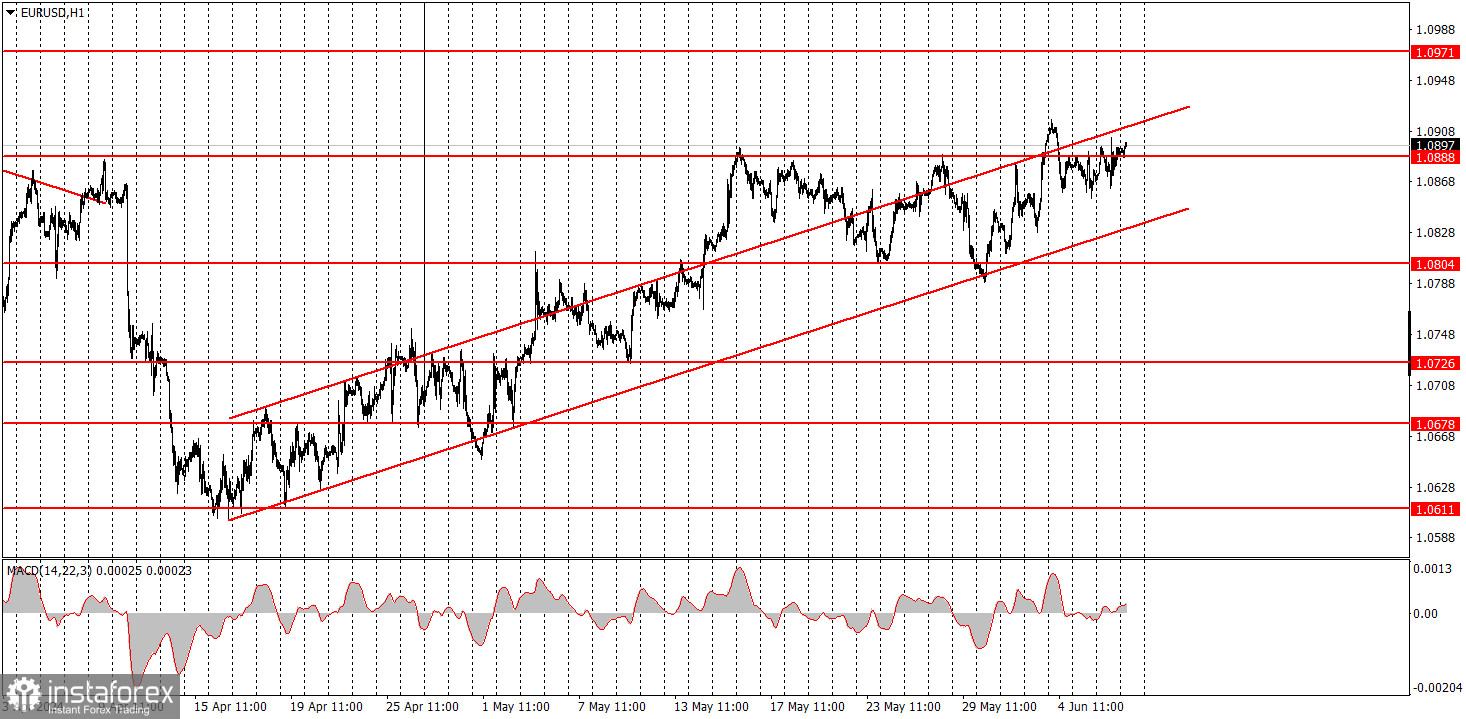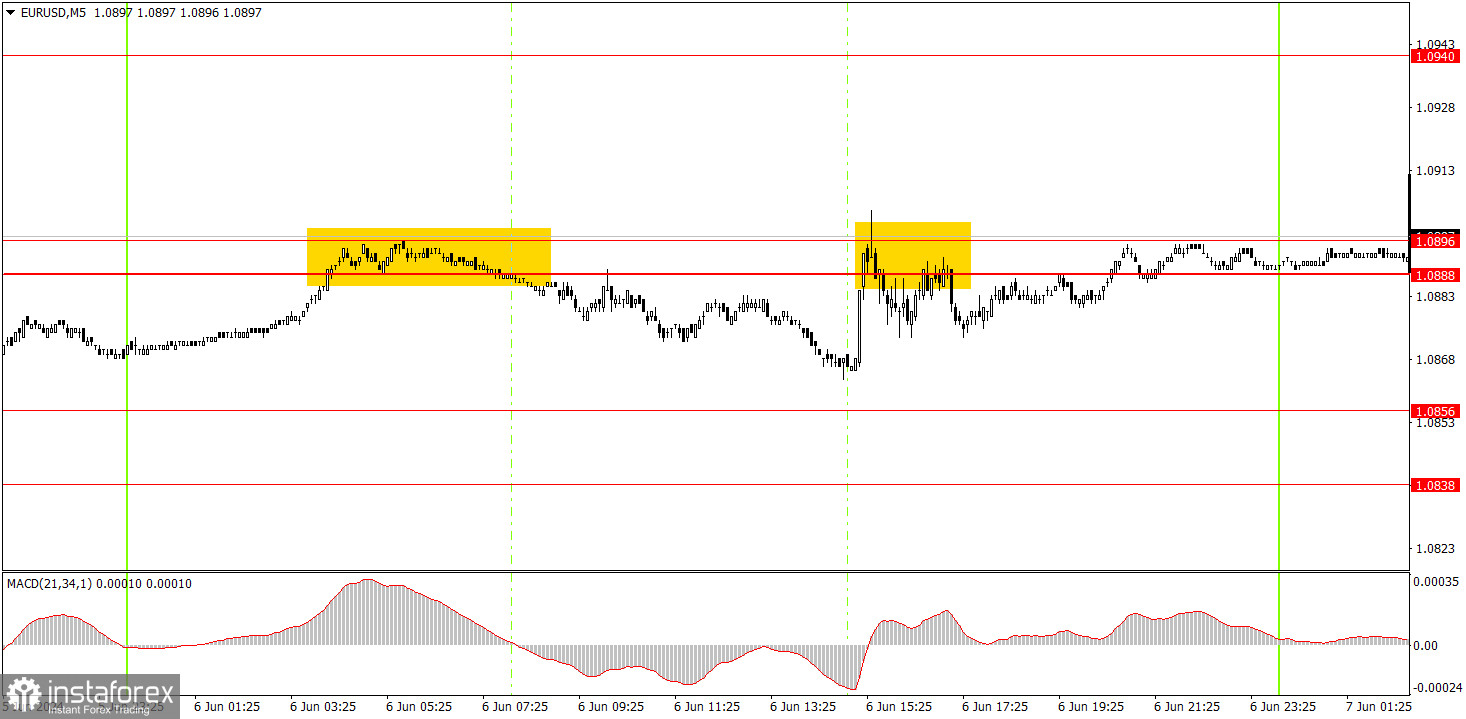Analysis of Thursday's deals:
1H chart of the GBP/USD pair.

The EUR/USD currency pair continued upward movement on Thursday with minimal volatility. The EUR/USD pair is trading strangely, illogically, and paradoxically, but unfortunately, this definition currently applies to many currency pairs on the market, such as GBP/USD. Yesterday, the results of the ECB meeting were announced. The European regulator cut the key rate for the first time within the monetary easing cycle. The euro practically did not react to this. Then, Christine Lagarde gave a speech. Even considering the ECB head did not say anything important, the market should have reacted somehow. However, the daily volatility was an unreal 40 points, and the market was in a state of hibernation all day. Thus, disregarding the fundamental background and the interpretation of macroeconomic statistics only in favor of the euro continues.
5-Minute Chart of EUR/USD

On the 5-minute timeframe on Thursday, two sell signals were formed. The price bounced twice from the 1.0888-1.0896 area. The first short position brought profit to novice traders, as it should have been closed manually before the ECB meeting results were announced. At that time, it was in a profit of about 15 points. Then, there was another bounce from the specified area, but no new price decline followed. The trade could be closed at breakeven or with minimal loss. Overall, with volatility around 40 points, expecting any profit was quite challenging.
How to Trade on Thursday:
On the hourly timeframe, the pair maintains an upward correction. The euro's fall should resume in the medium term as the global trend remains downward. However, the market continues to refrain from buying dollars for unknown reasons and cannot exit the upward channel. The fundamental background does not matter for the market, with most macroeconomic statistics being interpreted only in favor of the euro.
On Friday, novice traders can expect further growth of the euro. Especially if the key macroeconomic statistics from the US are weaker than forecasts. In this case, the euro could rise to the level of 1.0940.
On the 5-minute timeframe, the following levels should be considered: 1.0483, 1.0526, 1.0568, 1.0611, 1.0678, 1.0726-1.0733, 1.0797-1.0804, 1.0838-1.0856, 1.0888-1.0896, 1.0940, 1.0971-1.0981. On Friday, the Eurozone will publish the GDP report for the first quarter in the third estimate. While not a major report, it might still prompt a reaction. The much more significant Nonfarm Payrolls, unemployment, and wage data will be released in the US.
Main Rules of the Trading System:
- The strength of a signal is determined by the time it takes to form (bounce or break through a level). The less time it takes, the stronger the signal.
- If two or more trades are opened near a level based on false signals, all subsequent signals from that level should be ignored.
- In a flat market, any pair can generate many false signals or none at all. In any case, stopping trading at the first signs of a flat is better.
- Trades should be opened between the start of the European session and the middle of the American session, after which all trades should be closed manually.
- On the hourly timeframe, trade is based on MACD indicator signals if there is good volatility and a trend is confirmed by a trend line or channel.
- If two levels are too close together (5 to 20 points), they should be considered a support or resistance area.
- After moving 15 points in the right direction, set a Stop Loss to break even.
Explanation of the Charts:
- Support and resistance levels: Targets for opening buy or sell trades. Near them, Take Profit levels can be placed.
- Red lines: Channels or lines that show the current trend and indicate the preferred trading direction.
- MACD indicator (14,22,3): Histogram and signal line – an auxiliary indicator that can also be used as a source of signals.
Important speeches and reports (always listed in the news calendar) can greatly influence the currency pair's movement. Therefore, trade with maximum caution during their release or exit the market to avoid a sharp price reversal against the previous movement.
Beginners trading on the forex market should remember that only some trades can be profitable. Developing a clear strategy and money management are key to success in trading over the long term.





















